Gabriel Heinze’s managerial career has been in progress for almost a decade now. In that time, his ideas and application to the coaching side of the game have been spoken of in high regard. However, his teams are yet to really live up to the hype that always seems to surround the former Real Valladolid, Sporting CP, PSG, Manchester United, Real Madrid, Marseille and Roma centre-back.
His time at Vélez Sarsfield, from December 2017 to March 2020, remains his longest period at a club and represents the best period of his coaching career so far. On the other hand, though, his high-profile move to MLS side Atlanta United in December 2020 was a highly publicised disaster that knocked the young coach back a peg.
Indeed, Heinze remains a young coach at just 45 despite having spent eight years in the dugout at this stage. He’s got a decent amount of experience but still has time to learn from past mistakes and really nail it as a manager, living up to the expectation that comes for managers off the back of an illustrious playing career and well-known infatuation with the likes of Marcelo Bielsa — a legendary coach with a style of play adored by many.
The only club that Heinze played for professionally which we left off our list earlier was Newell’s Old Boys. It’s where he started and finished his playing career, and this is where we can find the 45-year-old plying his trade once again today — this time, on the sidelines rather than on the pitch.
He’s overseen 13 league games so far, all of Newell’s league games this term, and it’s been a bit of a mixed bag in terms of results. Newell’s currently sit 13th out of 28 teams, having won five, drawn three and lost five league fixtures.
This tactical analysis piece aims to provide some insight into Heinze’s start to life in the dugout at the fittingly named Estadio Marcelo Bielsa. We’ll look at some key strengths and weaknesses of this side while conducting an analysis of fundamental aspects of Leprosos’ strategy and tactics.
Shooting inefficiency
One thing that becomes blatantly obvious about Newell’s performances this season after watching their games and observing the data is that they’ve been very inefficient with their shooting.
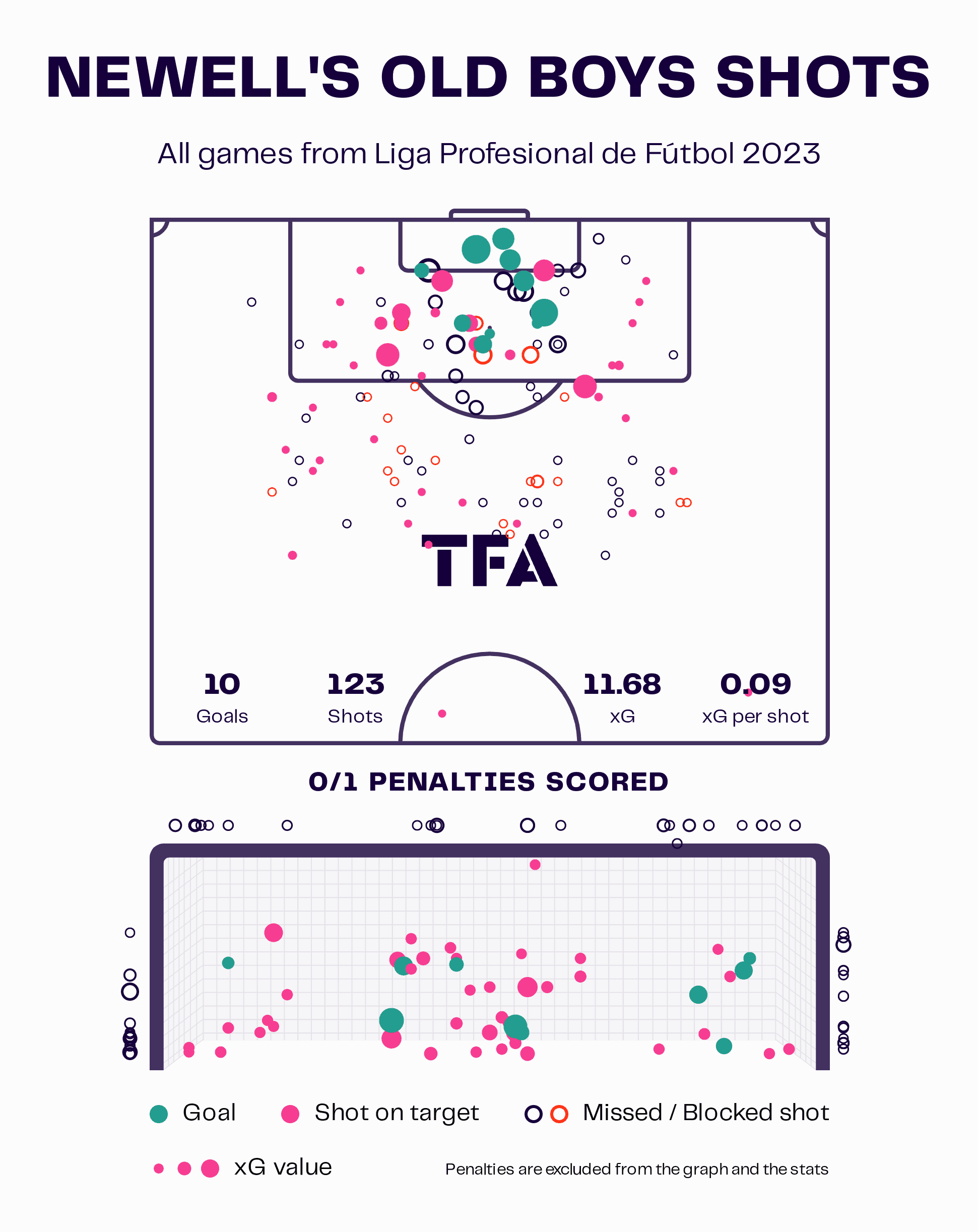
Their xG of 12.44 is the fourth-lowest in Argentina’s Liga Professional de Fútbol this season at the time of writing, this is including one penalty that’s excluded from the above graph showing their non-penalty xG for the 2023 campaign (11.68).
Their xG per shot of 0.09 is also fairly miserable and needs improving if Newell’s are to get themselves competing at the upper end of the table.
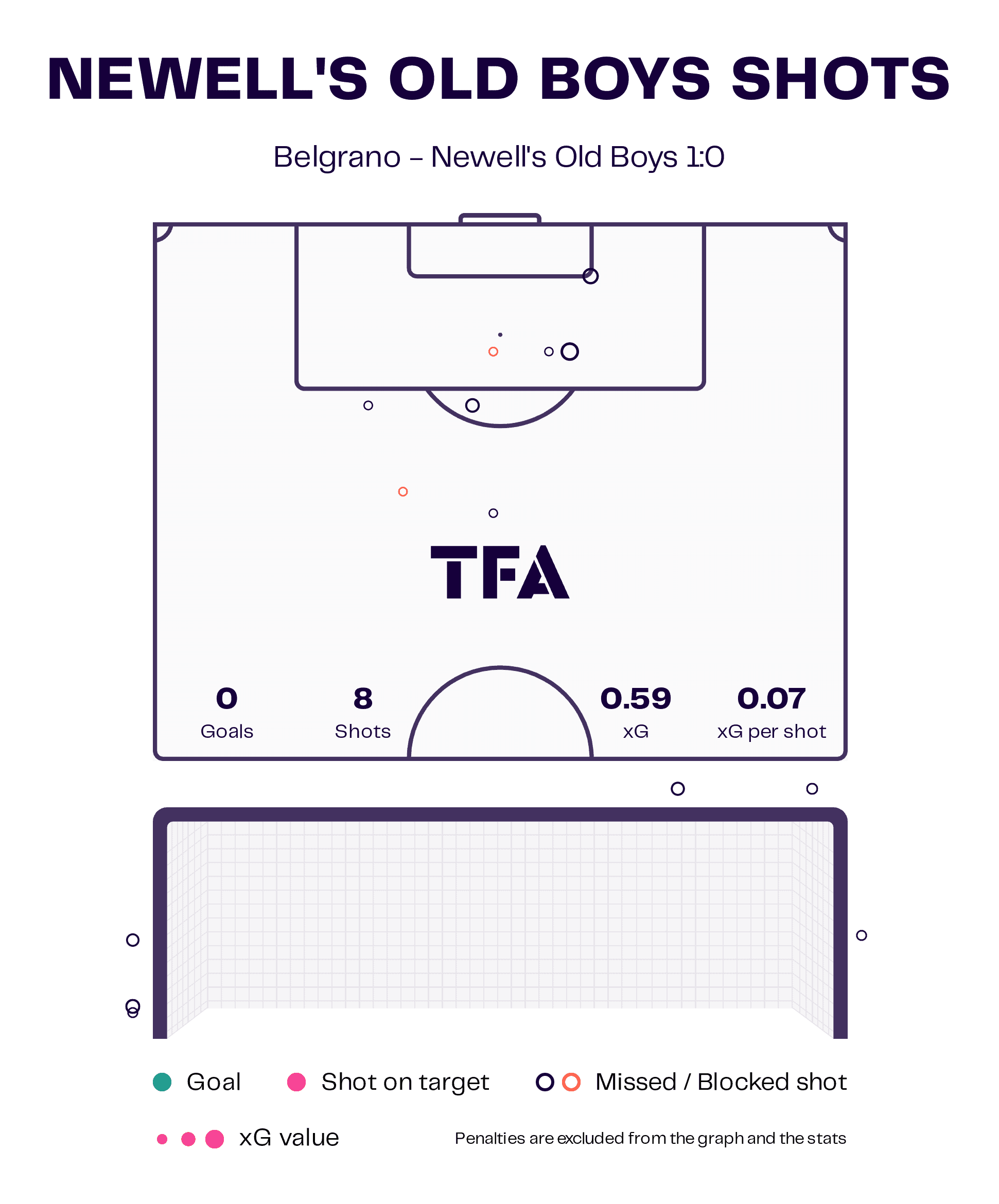
Their most recent league game, at the time of writing, came versus Belgrano and provides perhaps the best example of any game so far this season as to why they’ve been so poor going forward. This game saw Newell’s take eight shots, none of which hit the target. They ended the contest with an xG per shot of just 0.07 — nowhere near the quality of chance they’d be aiming to hit. This, combined with the fact they failed to generate that many opportunities in front of goal in this game, made it a goalless one for Heinze’s men.
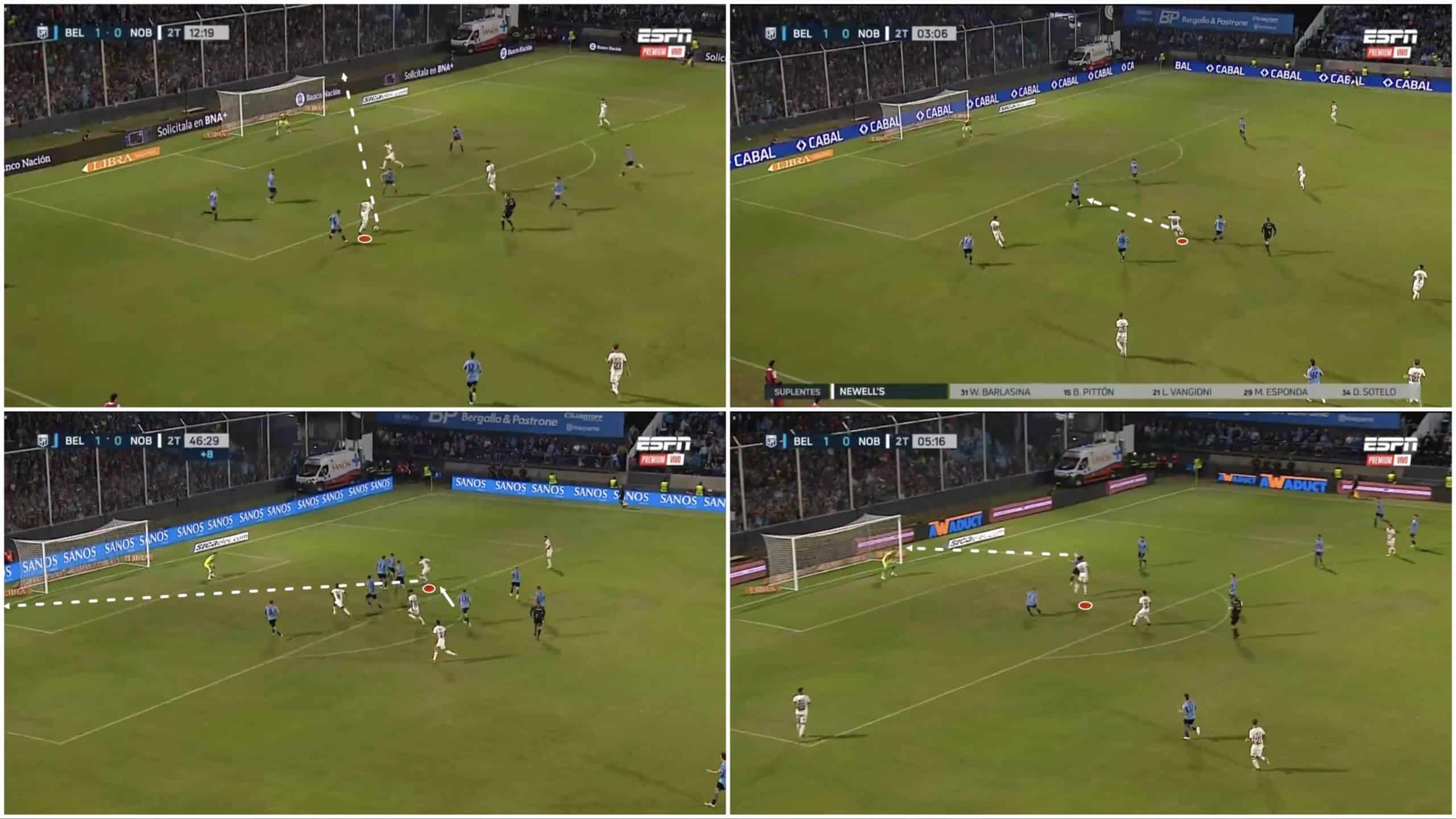
We see some examples of the shots Newell’s took in this game in figure 3. From this image, it becomes clear that Newell’s decision-making inside the final third needs addressing. They took on far too many long-range efforts or highly unlikely-to-score shots, passing up better options that could keep the attack moving into a more desirable goalscoring position.
In each of the four examples shown in figure 3, we’d argue a better passing option is available, yet the attacker took on the shot.
This isn’t a problem exclusive to Newell’s game with Belgrano, it’s been an issue for their season so far. We do believe individual decision-making was the key issue in these situations but nevertheless, this is an important issue for Heinze to address and try to rectify.
Ball progression
Looking at how his team progresses the ball, we can clearly see Heinze’s stamp in plenty of areas.
Newell’s ended the previous league season with 10.71 progressive runs per 90 (13th in Liga Professional de Fútbol) and 22.88 dribbles per 90 (25th in Liga Professional de Fútbol). This season, ball-carrying and dribbling have become absolutely key elements of Newell’s approach, particularly in terms of how they like to play in the progression phase.
So far this term, Newell’s are averaging 13.64 progressive runs per 90 (fourth-most in the league) and 29.32 dribbles per 90 (again, fourth-most in the league).
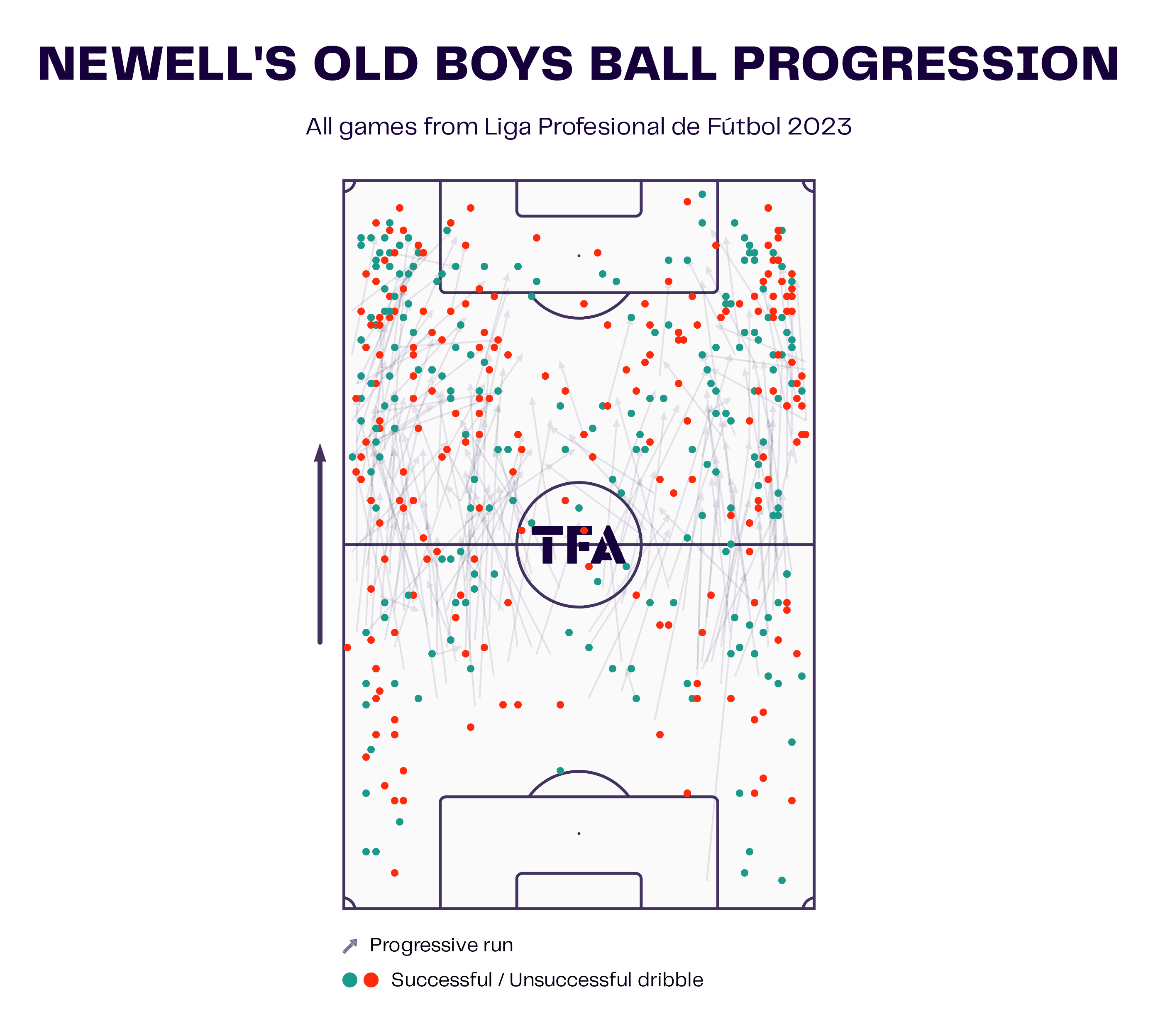
Figure 4 shows Newell’s progressive run and dribble locations from 2023. We see a lot of Newell’s ball progression coming via the wider areas of the pitch, as well as a lot of dribbling attacks coming from wide inside the final third.
At Newell’s, Heinze has placed a lot of importance on his wingers providing width inside the final third, with wide central midfielders pushing up into the half-spaces and supporting the striker more centrally.
This occurs when he lines his team up in a 4-3-3, as has been most common this season, and in a 3-4-3 to an extent, though less often. Generally, we’ve seen their wing-backs push up into the wide areas high upfield when lined up in a 3-4-3 which hasn’t always been the case throughout Heinze’s managerial career.
In the past, when playing with three centre-backs, it’s been common to see Heinze’s teams vacate the typical ‘holding midfield’ position, with the central centre-back pushing up to occupy that space. We haven’t seen this a lot in Heinze’s current venture but perhaps it’s something he’ll look to implement as time passes at Newell’s depending on the opposition and what suits his available personnel.
So far, it’s been more common to see him starting in a typical 4-3-3 with one holding midfielder and sometimes dropping that midfielder deeper rather than the opposite way around. This has liberated the two wide central midfielders, giving them a lot of freedom to get forward in possession.
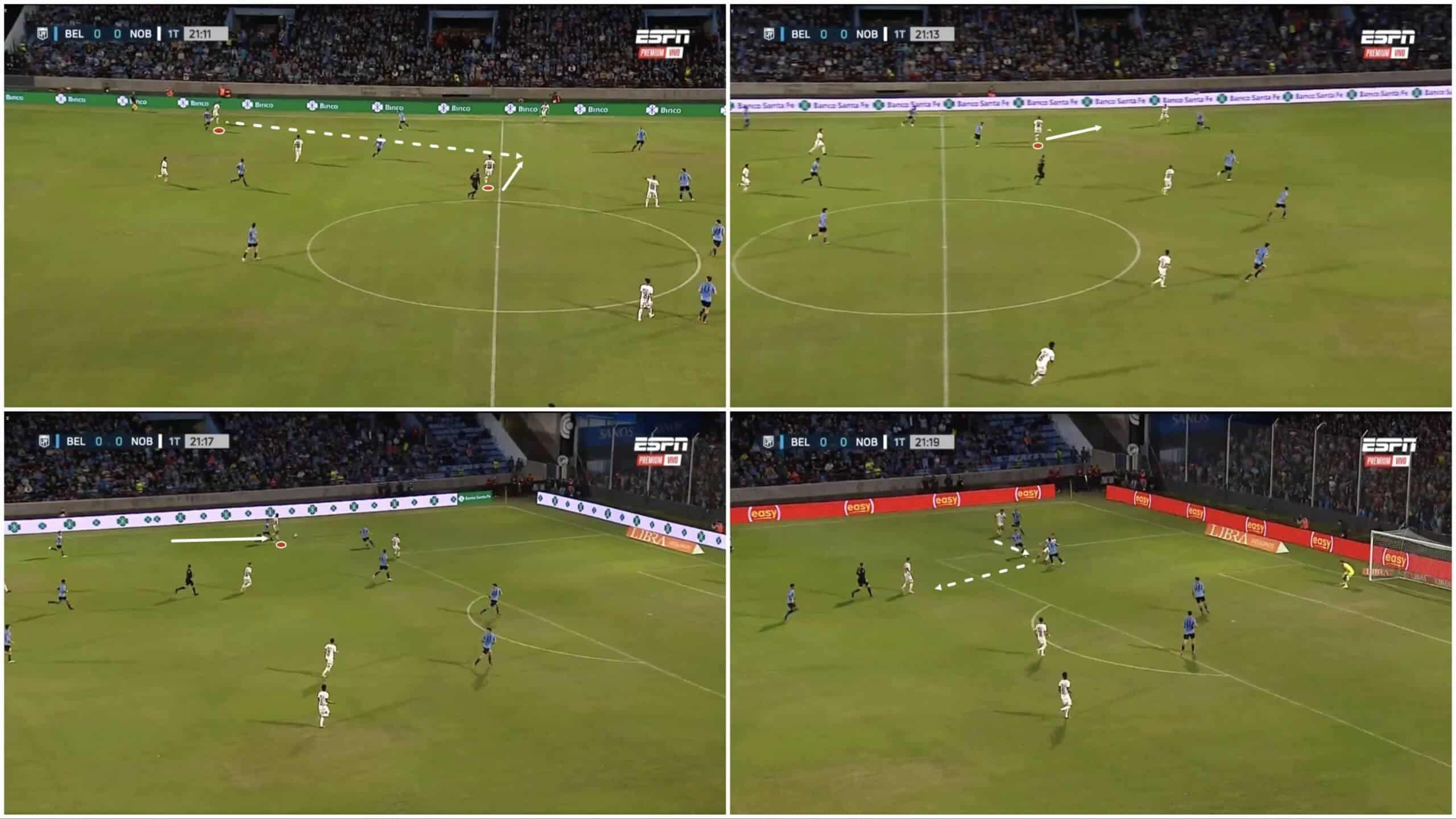
When lining up with a back three, as was the case for figure 4, the wingers get narrower and look to create via the half-spaces in the kinds of areas that the wide central midfielders are typically found between the opposition’s midfield and defensive lines.
Here, the winger receives centrally and carries the ball out wide, driving forward and entering the final third before linking up with the striker who can lay it off to a free man on the edge of the area. This creates a good opportunity for Newell’s to generate a decent shooting opportunity, though the chance is ultimately snatched at and the attack fizzles out to little — again spotlighting some questionable decision-making from Heinze’s men inside the final third.
The ways of progressing the team into the final third in the first place and getting into these positions have been effective, however, and the coach deserves some credit for putting a structure in place and training it effectively enough that it allows Newell’s to break the opposition down like this by exploiting space between the lines via rotations between the wing-back, central midfielder and winger.
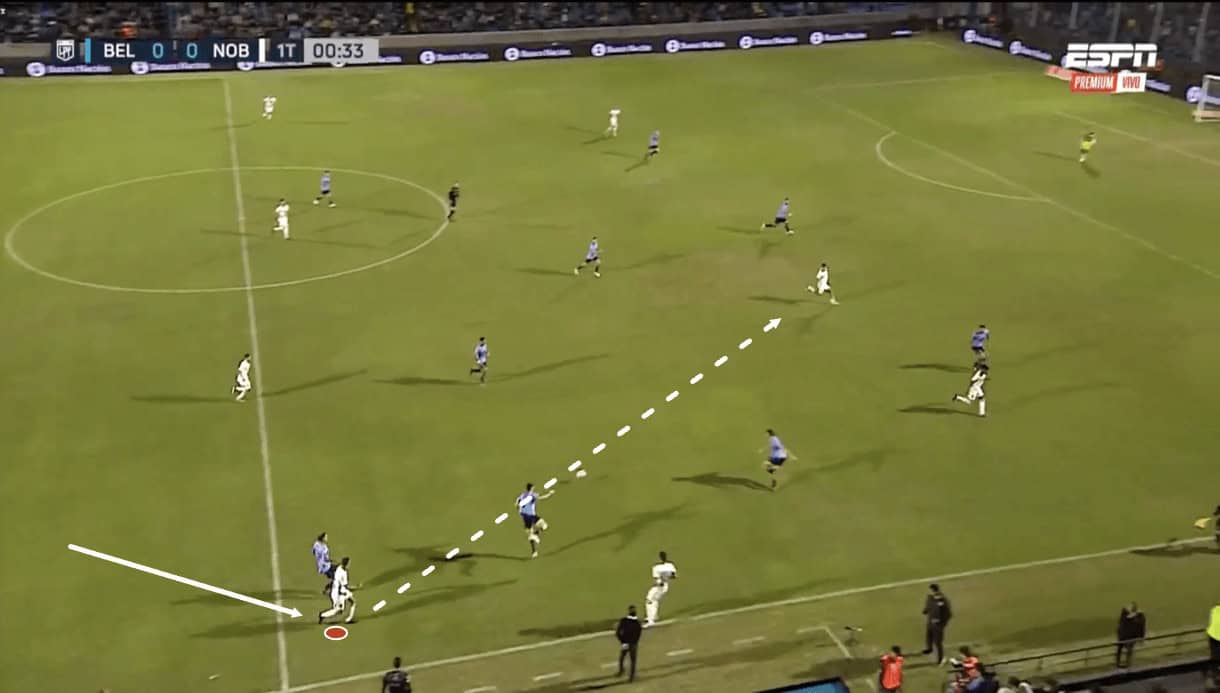
While we haven’t seen the central centre-back stepping up into a holding midfielder position very often this season, we have seen the wide centre-backs carrying the ball forward to exploit space in the wide areas or deep half-spaces from where they’ll look to progress the ball.
Again, it’s been a staple of Heinze’s teams throughout his coaching career to see centre-backs exploding forward into more advanced positions and that’s been the case again at Newell’s.
Above in figure 5, we see an example of right centre-back Víctor Velázquez breaking opposition lines by drilling the ball forward into the centre-forward’s feet after he was given some space to roam into with the ball while bringing it out from the back. This helps Newell’s progress into the final third and enjoy a good chance to put the ball into a good goalscoring position.
Building via the wide areas, be that through centre-backs, wing-backs, central midfielders or wingers has been another staple of Heinze’s teams throughout his coaching career. He likes fluid movement, brave ball-carrying and positional rotations — all of which have been seen in the examples shown throughout this section of analysis. In that regard, we can clearly see some ways in which the 45-year-old has put his stamp on Newell’s when looking at their ball progression this season.
Defensive approach
Lastly, we must discuss Newell’s defensive approach under Heinze. The Rosario-based side have conceded the joint-sixth fewest goals (12) of any Liga Professional de Fútbol side this term. These 12 goals have been conceded from 16.2 xGA, which ranks 13th in the division.
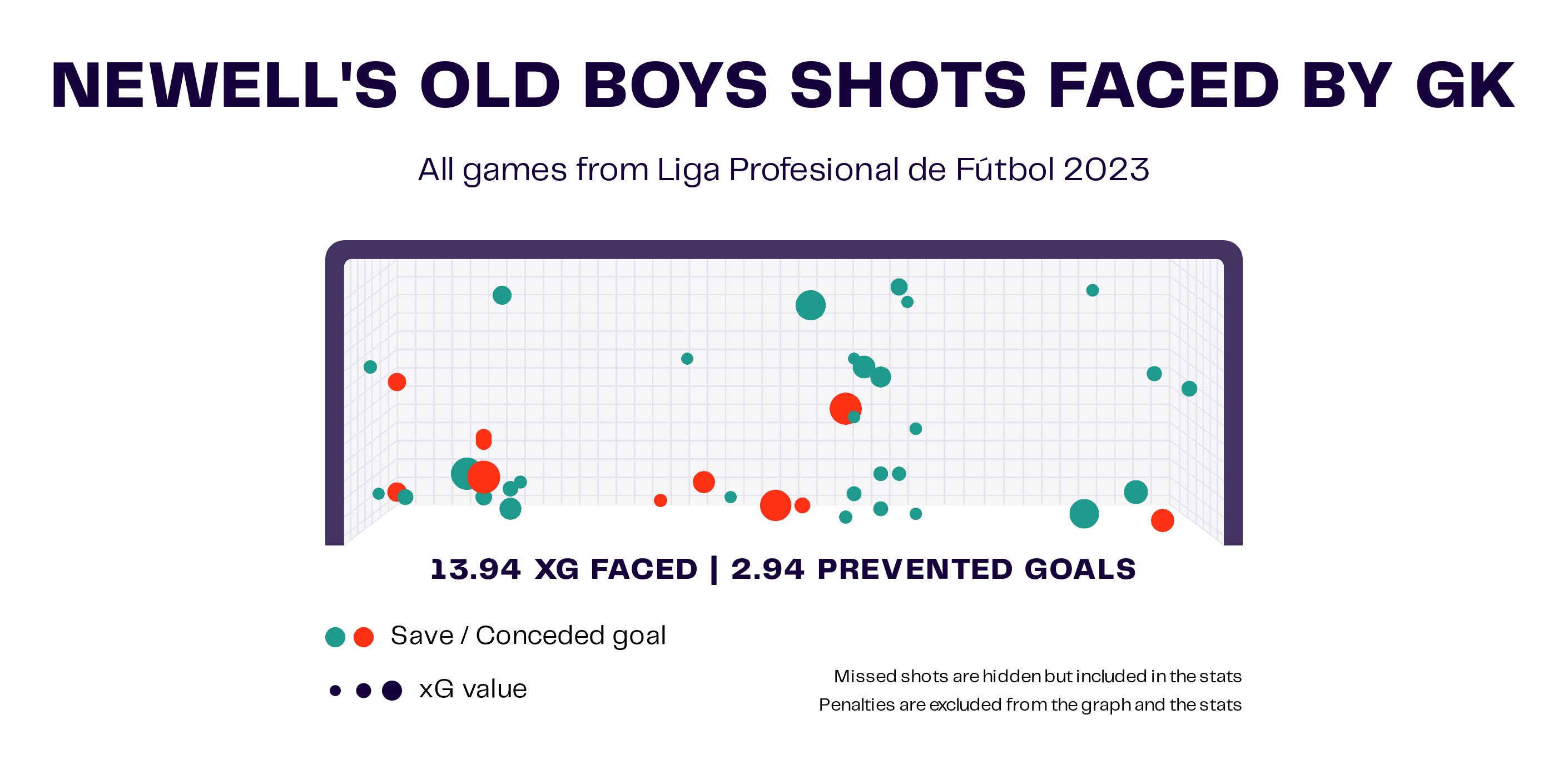
With non-penalty shots faced by Newell’s this term shown in figure 6, we can say that the goalkeeper and captain, Lucas Hoyos, has done an excellent job in helping his team out of trouble at times this term, preventing almost three goals so far.
Heinze likes his teams to defend aggressively and that’s been no different with Newell’s this season. His team currently has a PPDA of 7.69 — the eighth-lowest in Liga Professional de Fútbol.
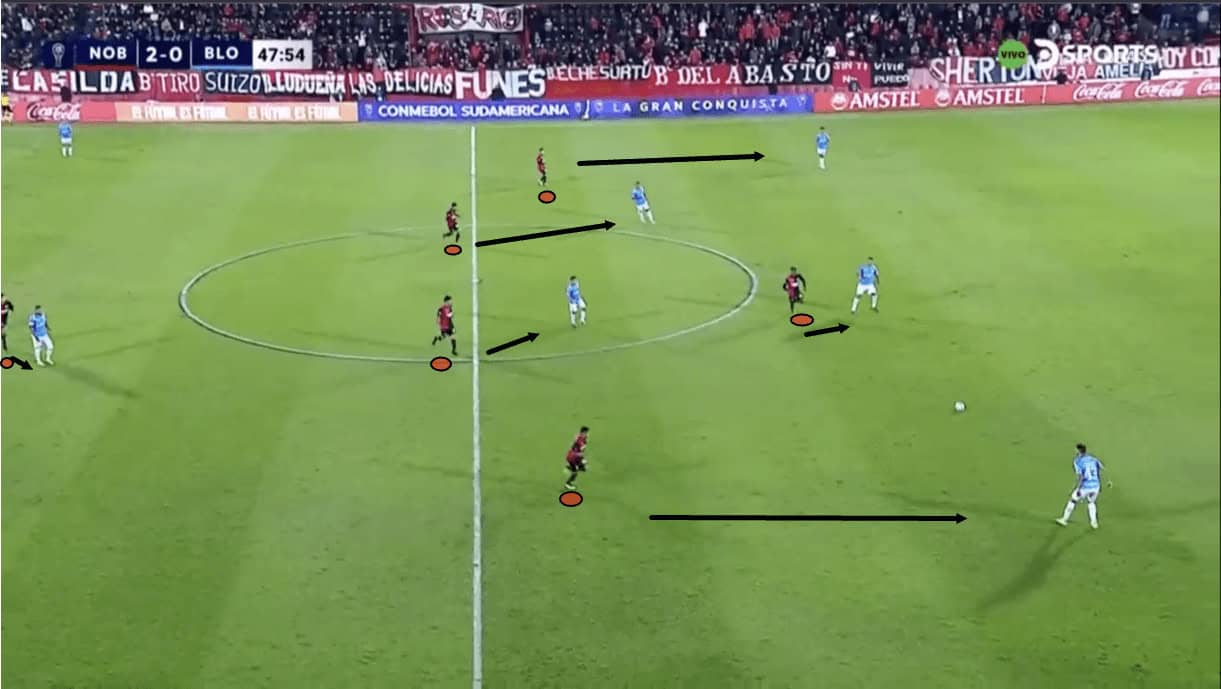
Energy and commitment are important elements of Newell’s approach off the ball in order to ensure they win the ball back high upfield, as is tight marking. Newell’s have a fairly man-oriented approach and Heinze likes his team to at least match up with the opposition’s build-up numerically, ensuring they can’t find a free man that easily. We see an example of this in figure 7.
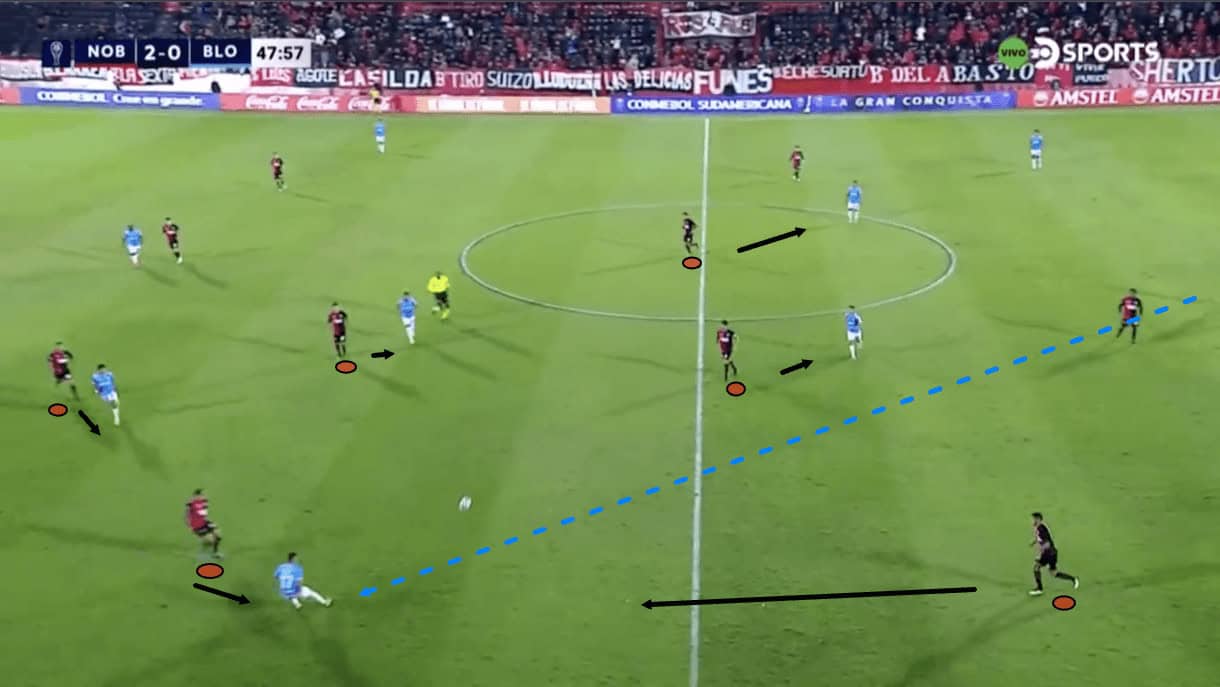
Moving on into figure 8 here, we see how the opposition were then forced to play a more risky pass to try and beat Newell’s press by going over them as opposed to through them via intricate passing play — Heinze’s men made this difficult to achieve via their energy, positioning and tight marking.
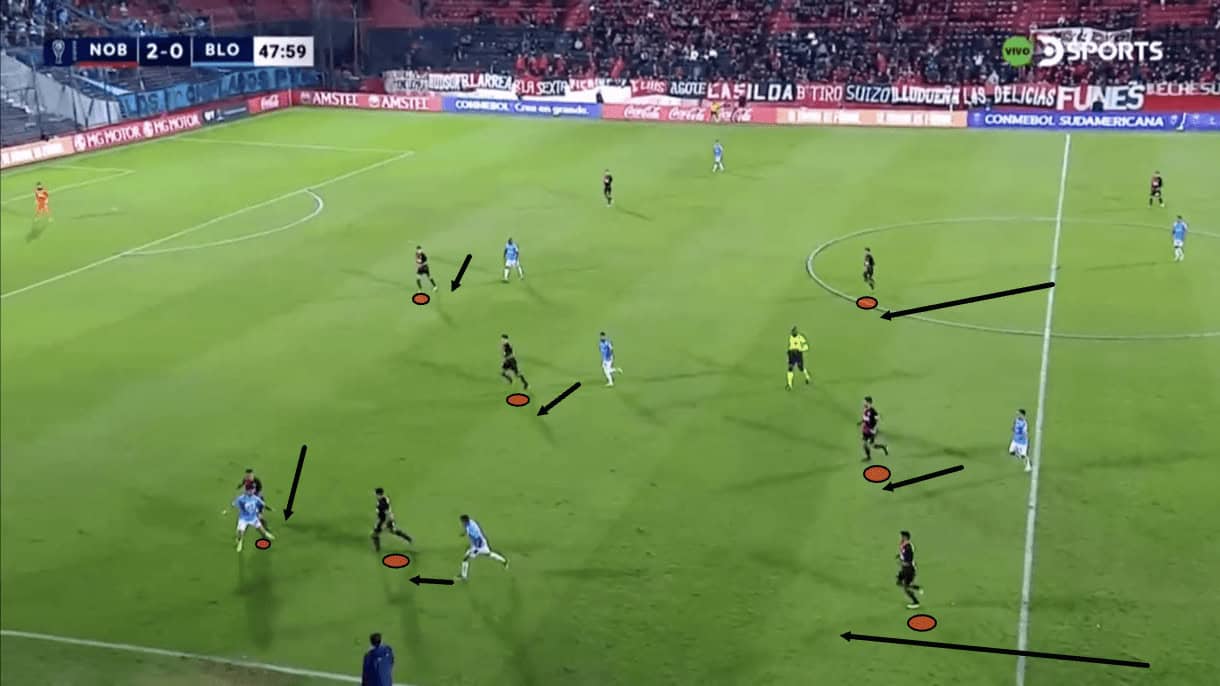
As the opposition settle out wide, attempting to break through Newell’s via the wing, we see how the near centre-back steps out to follow an attacker dropping out wide, while the near full-back, central midfielder, winger and holding midfielder all come across as well, staying very close to the same man they’d been marking the whole time.
The ball-far central midfielder, meanwhile, moves further away from his man and this achieves a couple of things: firstly, he provides more support to his teammates by applying pressure on the ball carrier out wide here and if one of them is dribbled past, he’ll be there to try and halt any further progression.
Additionally, by distancing himself from the opposition player centrally here a little bit, he makes himself an excellent passing option should Newell’s regain possession and create an opportunity to counterattack.
Still, the midfielder retains access to his man in case the opposition switch the play at any point, so he must remain aware.
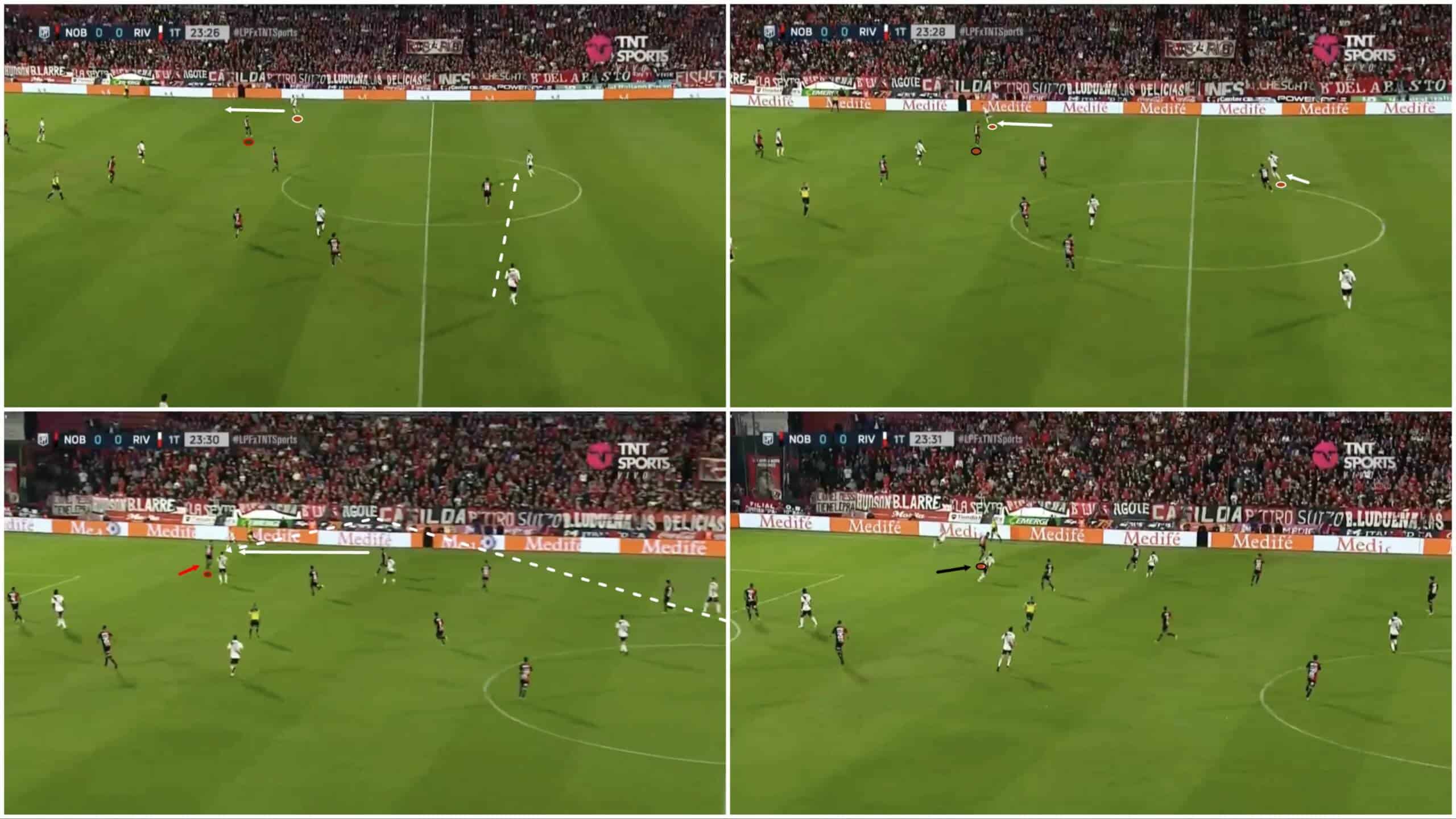
Awareness of space and movement around them is another key trait for Newell’s players to have out of possession. It could be very easy for an opposition player to peel away off a Newell’s player’s shoulder unmarked as was the case here in the top half of the image, with the opposition wide man on the right bolting away when the Newell’s winger beside him takes his eye off him.
However, the full-back behind did an excellent job of remaining aware and managed to cover off the long ball looking for the run in behind. Concentration is key in this system given how important tight marking is. If an opposition player finds freedom, this can create chaos for Newell’s defence.
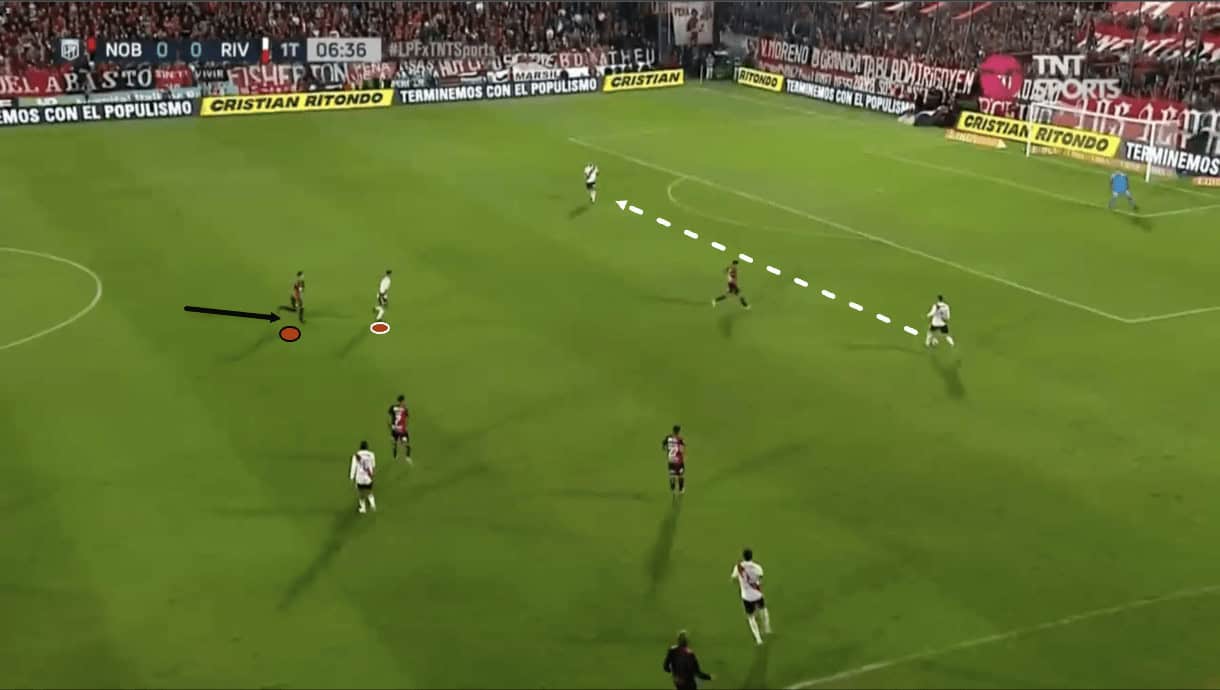
When pressing high, it isn’t always man-for-man, as the striker may find themselves pressing both centre-backs in Newell’s 4-3-3/3-4-3, as was the case here in figure 11. This can give Newell’s an extra man at the back where they really don’t want to be outnumbered. Wingers and midfielders will support the striker, however.
Here, we see Newell’s left central midfielder moving to press the opposition’s right centre-back as they receive the ball but in order to do so, he needs to ensure the holding midfielder positioned centrally behind their press is covered.
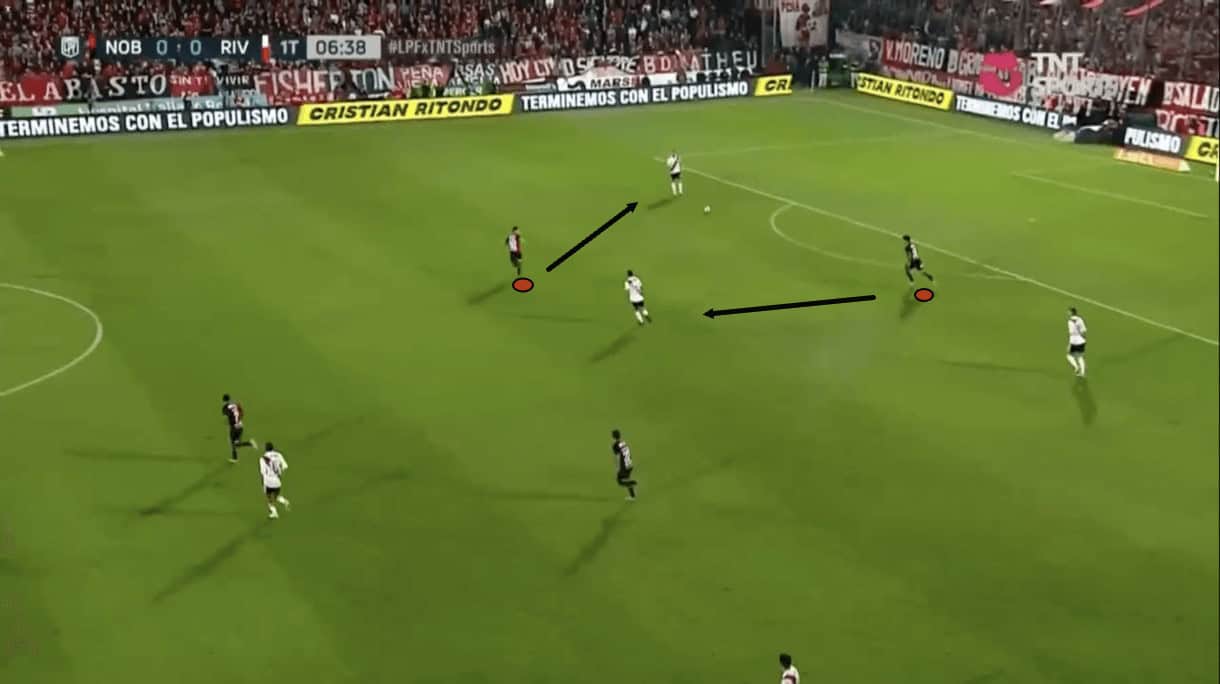
He achieves this by simply communicating with the striker that he’ll press the centre-back but the holding midfielder needs picking up — a job the striker must now carry out quickly.
Like clockwork, the right centre-back is under immediate pressure from a closer player and the forward pass to the holding midfielder will, again, be cut off for the opposition thanks to Newell’s organisation and marking.
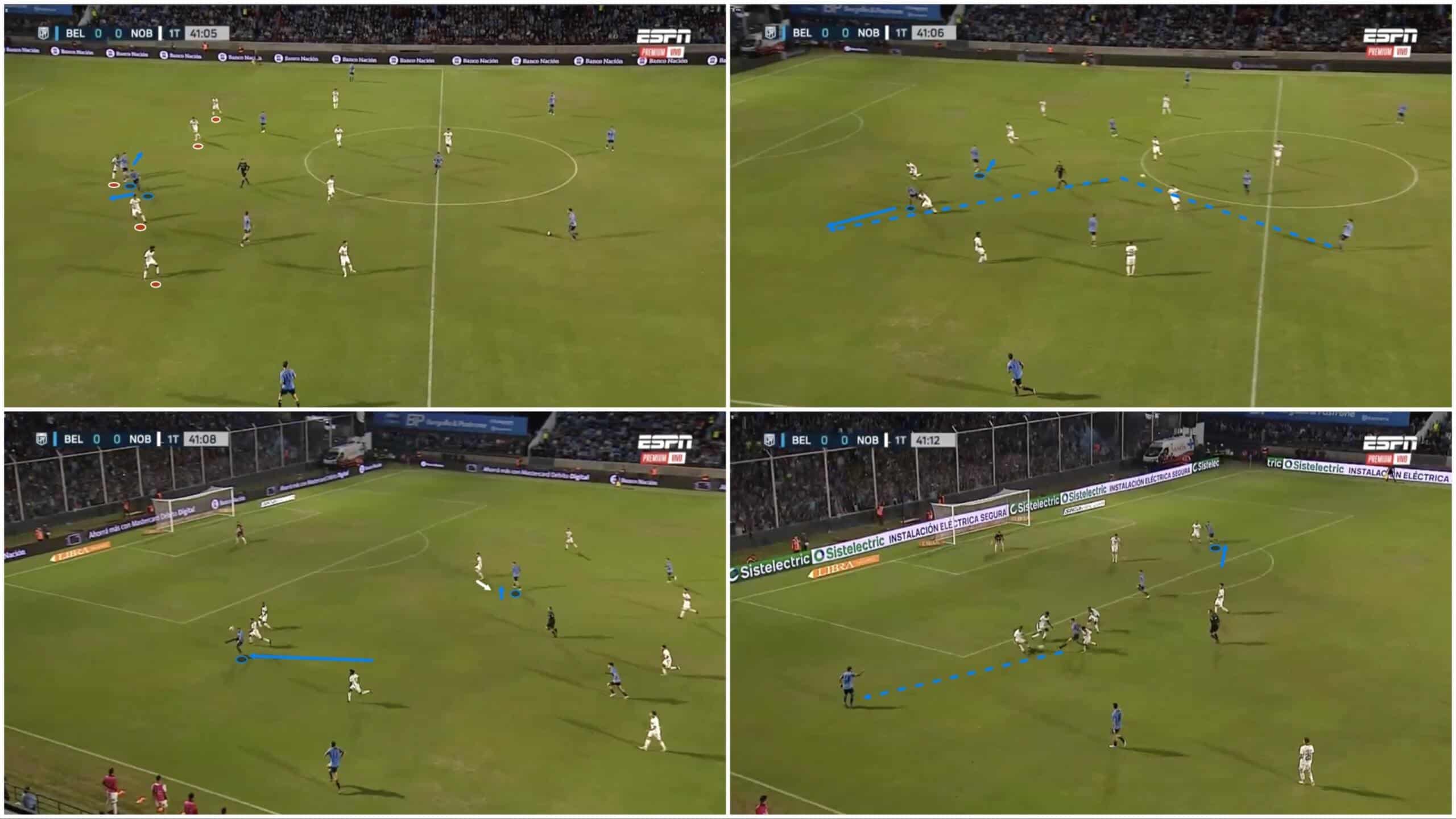
One downside to Newell’s defending this season has been how opposing players have, at times, managed to find space between their defenders. Even if it’s just for a second or two as the centre-backs pass the player off between each other, it can be dangerous if the opposition are aware of this issue and aim to exploit it via passing and, crucially, the striker’s movement.
We see an example of how the striker, Pablo Vegetti in this case moving from left to right and circled in the images, sometimes found some space between the centre-backs that could’ve been exploited. This happened shortly after this image ends and the opposition score to put Newell’s behind.
So, in general, Newell’s defending has been solid this season but when they’ve conceded chances, they’ve conceded big ones. Their xGA per shot sits at 0.132 — the third-highest in Argentina’s top flight. Thankfully, for them, they’ve managed to keep shots against low, so their overall defensive record remains acceptable but with room for improvement.
Conclusion
To conclude this tactical analysis of Heinze’s Newell’s Old Boys tenure so far, there’s been some really positive signs on the ball, especially in how the team are progressing the play and improving their ball-carrying quality, which has undoubtedly been entertaining to watch.
However, there are major issues in terms of decision-making inside the final third and shot selection that need to be addressed in order to improve their offensive record.
Defensively, Newell’s have largely performed well in terms of denying opponents opportunities but they’ve also relied on their ‘keeper massively to prevent the chances they do concede from going in — they must reduce the average quality of chances against.
However, I’d say Newell’s fans can largely be optimistic about their future under Heinze, as there are already some clear areas in which the 45-year-old has had a significant positive impact at Estadio Marcelo Bielsa.





Comments